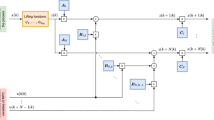Abstract
To improve the accuracy of thermal characteristics analysis of motorized spindle, an online correction model of thermal boundary conditions is proposed based on BP neural network (BPNN), the experimental data and simulation results are used to construct the BPNN model to correct the thermal boundary conditions of motorized spindle. Based on the co-simulation of Ansys, Matlab, and LabVIEW, a digital twin system for thermal characteristics is built to precisely predict the temperature field and thermal deformation of a motorized spindle under varied operating conditions. The experimental results show that the prediction accuracy of temperature field is greater than 98%, and the prediction accuracy of thermal deformation is greater than 96%, which effectively improves the simulation accuracy and robustness of thermal characteristics, and provides the foundation for the error compensation and thermal optimization design.












Similar content being viewed by others
Data availability
All data generated or material during this study are included in this published article.
Code availability
All the Matlab, APDL, and LabView code are available.
References
Wu Y, Wang X, He Y, Huang X, Xiao L, Guo L (2021) Review on the technology and application of digital twin in manufacturing industry. Modern Manuf Eng 09:137–145. https://doi.org/10.16731/j.cnki.1671-3133.2021.09.023
Li H, Wang H, Liu G, Wang J, Evans S, Li L, Wang XC, Zhang S, Wen XY, Lie FQ, Wang XC, Hao B, Jiang W, Liu YG (2021) Concept, system structure and operation mode of industrial digital twin system. Comput Integr Manuf Syst 27(12):3373–3390. https://doi.org/10.13196/j.cims.2021.12.001
Miao T, Zhang X, Xiong H, Zhuang C, Zhao H, Lv Z, Liu JH (2019) Application and expectation of digital twin in product lifecycle. Comput Integr Manuf 25(6):1546–1558. https://doi.org/10.13196/j.cims.2019.06.022
Liu J, Cao X, Zhou H, Li L, Liu X, Zhao P, Dong J (2021) A digital twin-driven approach towards traceability and dynamic control for processing quality. Adv Eng Inform 50:101395. https://doi.org/10.1016/j.aei.2021.101395
Lu Y, Zhao Z, Wang W, Zhang K (2021) Digital twin product lifecycle system dedicated to the constant velocity joint. Comp Elec Engi 93:107264. https://doi.org/10.1016/j.compeleceng.2021.107264
Deng X, Lin H, Wang J, Xie C, Fu J (2018) Review on thermal design of machine tool spindles. Opt Precision Eng 26(06):1415–1429. https://doi.org/10.3788/OPE.20182606.1415
Fan L, Jing X, Zhang K, Zhu C (2020) Thermal deformation modeling and analysis of high speed motorized spindle based on PLS. J Shenyang Jianzhu Univ (Natural Science) 36(04):738–744. https://doi.org/10.11717/j.issn:2095-1922.2020.04.20
Uhlmann E, Hu J (2012) Thermal modelling of a high speed motor spindle. Procedia CIRP 1:313–318. https://doi.org/10.1016/j.procir.2012.04.056
Zhang L, Li C, Li J, Zhang K, Wu Y (2017) The temperature prediction mode of high speed and high precision motorized spindle. J Mech Eng 53(23):129–136. https://doi.org/10.3901/JME.2017.23.129
Zhang L, Gong W, Zhang K, Wu Y, An D, Shi H, Shi Q (2018) Thermal deformation prediction of high-speed motorized spindle based. Int J Adv Manuf Technol 97:3141–3151. https://doi.org/10.1007/s00170-018-2123-6
Song S, Yovanvich MM (1988) Relative contact pressure - dependence on surface roughness and Vickers microhardness. J Thermophys Heat Transfer 2(1):43–47. https://doi.org/10.2514/3.60
Ishizaki T, Igami T, Nagano H (2020) Measurement of local thermal contact resistance with a periodic heating method using microscale lock-in thermography. Rev Sci Instrum 91(6):0640901. https://doi.org/10.1063/5.0002937
Yu Y, Li Z, Zheng X (2018) The inverse problem of thermal contact resistance between rough surfaces. Chin J Theor Appl Mech 50(3):479–486. https://doi.org/10.6052/0459-1879-18-076
Li H, Ying X (2010) A design method of temperature measurement points for thermal error of machine spindle. China Mech Eng 21(07):804–808
Fan K (2017) Research on the machine tool’s temperature spectrum and its application in a gear form grinding machine. Int J Mach Tools Manuf 90:3841–3850. https://doi.org/10.1007/s00170-016-9722-x
Moorthy R, Raja V (2014) An improved analytical model for prediction of heat generation in angular contact ball bearing. Arab J Sci Eng 39:8111–8119. https://doi.org/10.1007/s13369-014-1351-9
Fan K, Gao R, Zhou H, Le W, Shen R, Xu Y, Zhao Y, Lu Q, Wang R, Li Y (2018) Study on the on-line correction of thermal parameters for machine tools. Mech Eng Technol 7(06):480–486. https://doi.org/10.12677/MET.2018.76059
Beriache M, Bettahar A, Naji H, Loukarfi L, Mokhtar Saïdia L (2012) Fluid Flow and Thermal Characteristics of a Minichannel Heat Sink with Impinging Air Flow. Arab J Sci Eng 37:2243–2254. https://doi.org/10.1007/s13369-012-0321-3
Fang B, Cheng M, Gu T, Ye D (2022) An improved thermal performance modeling for high-speed spindle of machine tool based on thermal contact resistance analysis. Int J Adv Manuf Technol 120:5259–5268. https://doi.org/10.1007/s00170-022-09085-4
Yan Z, Tao T, Hou R, Du H, Mei X (2020) A new modeling method for thermal errors of motorized spindle based on the variation characteristics of spindle temperature field. Int J Adv Manuf Technol 110:989–1000. https://doi.org/10.1007/s00170-020-05752-6
Liu Y, Miao E, Zhang M, Feng D, Li J (2021) Selection of robust temperature-sensitive points for CNC machine tools. Opt Precision Eng 29(05):1072–1083. https://doi.org/10.37188/OPE.20212905.1072
Raja V, Moorthy R (2019) Prediction of Temperature Distribution of the Spindle System by Proposed Finite Volume and Element Method. Arab J Sci Eng 44:5779–5785. https://doi.org/10.1007/s13369-019-03732-x
Author information
Authors and Affiliations
Contributions
Fan pointed out the research direction and the feasibility of the experiment. Yi operated all the experiments, programmed, and wrote the manuscript. Fan finally polished the manuscript.
Corresponding author
Ethics declarations
Ethics approval
The authors confirm that this work is an original work and has not been published in other places, and all the data is true.
Consent to participate
The authors consent to participate.
Consent for publication
The authors consent to publish the paper.
Competing interests
The authors declare no competing interests.
Additional information
Publisher's note
Springer Nature remains neutral with regard to jurisdictional claims in published maps and institutional affiliations.
Rights and permissions
Springer Nature or its licensor (e.g. a society or other partner) holds exclusive rights to this article under a publishing agreement with the author(s) or other rightsholder(s); author self-archiving of the accepted manuscript version of this article is solely governed by the terms of such publishing agreement and applicable law.
About this article
Cite this article
Yi, H., Fan, K. Co-simulation-based digital twin for thermal characteristics of motorized spindle. Int J Adv Manuf Technol 125, 4725–4737 (2023). https://doi.org/10.1007/s00170-023-11060-6
Received:
Accepted:
Published:
Issue Date:
DOI: https://doi.org/10.1007/s00170-023-11060-6




